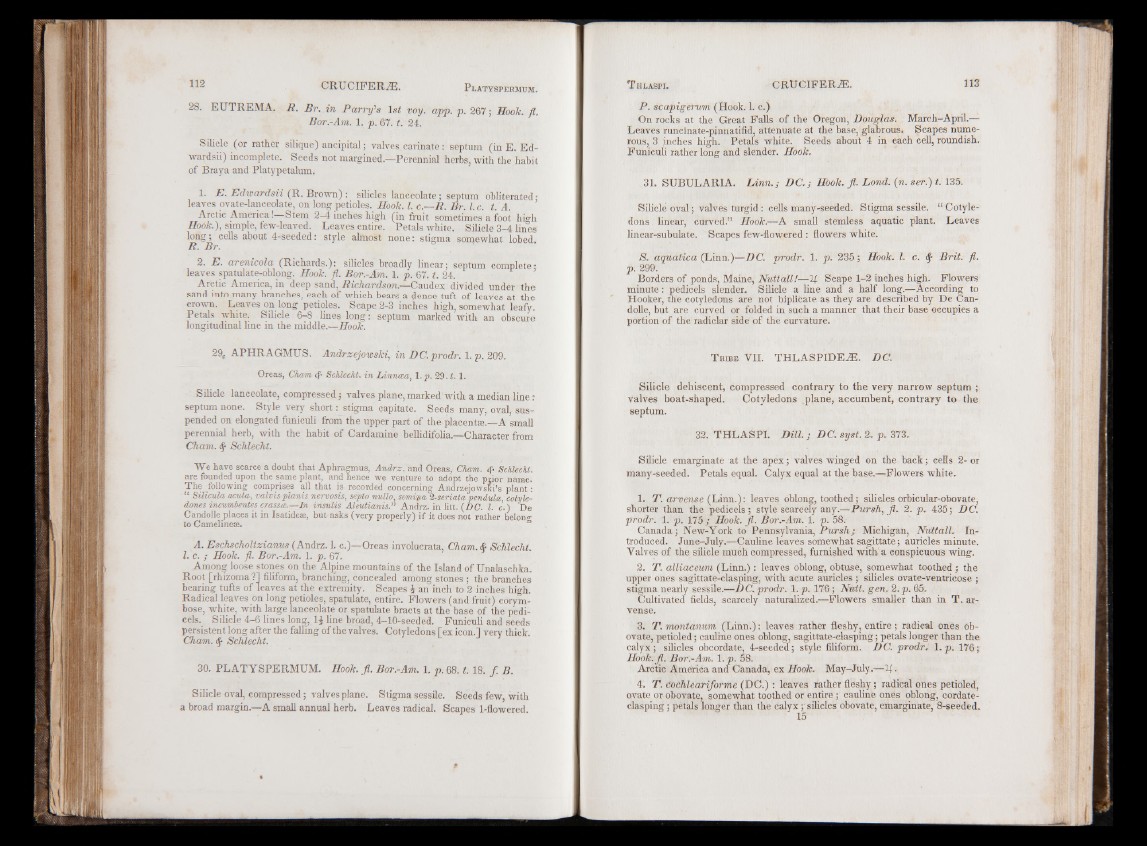
28. EUTREMA. R . Br. in Parry's 1st voy. app. p. 267; Hook. fl.
Bor.-Am. 1. p. 67. t. 24.
Silicle (or rather silique) ancipital; valves carinate: septum (in E. Ed-
wardsii) incomplete. Seeds not margined—Perennial herbs, with the habit
of Braya and Platypetalum.
1. E . Edivardsii (R. Brown) : silicles lanceolate; septum obliterated;
leaves ovate-lanceolate, on long petioles. Hook. 1. c.—R. Br. 1. c. t. A.
Arctic America! Stem 2-4 inches high (in fruit sometimes a foot high
HoOk.), simple, few-leaved. Leaves entire. Petals white. Silicle 3-4 lines
long; cells about 4-seeded: style almost none: stigma somewhat lobed.
R. Br.
2. E . arenicola (Richards.): silicles broadly linear; septum complete;
leaves spatulate-oblong. Hook. fl. Bor.-Am. 1. p. 67. t. 24.
Arctic America, in deep sand, Richardson.—-Caudex divided under the
sand into many branches, each of which bears a dense tuft of leaves at the
crown. Leaves on long petioles. Scape 2-3 inches high, somewhat leafy.
Petals white. Silicle 6-8 lines long: septum marked with an obscure
longitudinal line in the middle.—Hook.
29« APHRAGMUS. Andrzejowski, in DC. prodr. 1. p. 209.
Oreas, Cham Schlecht. in Linnosa, l.p. 29.1.1.
Silicle lanceolate, compressed; valves plane, marked with a median line:
septum none. Style very short: stigma capitate. Seeds many, oval, suspended
on elongated funiculi from the upper part of the placenta;.—A smalt
perennial herb, with the habit of Cardamine bellidifolia.—Character from
Cham. Schlecht.
We have scarce a doubt that Aphragmus, Andrz. and Oreas, Cham. <$• SchlecU.
are founded upon the same plant, and hence we venture to adopt the prior name.
The ^following comprises all that is recorded concerning Andrzejowsfti’s plant:
“ Silicula acuta, valvis plants nervosis, septa nullo, semina 2-seriata pendula, cotyle-
dones incumbentes crassce.—In insulis Almtianis.” Andrz. in litt. fDC- 1. c.) De
Candolle places it in Isatideae, but asks (very properly) if it does not rather beloiw
to Camelineae.
A. Eschscholtzianus (Andrz. 1. c.)—Oreas involucrata, Cham. & Schlecht.
1. c. ; Hook. fl. Bor.-Am. 1. p. 67.
Among loose stones on the Alpine mountains of the Island of Unalaschka.
Root [rhizoma?] filiform, branching, concealed among stones; the branches
bearing tufts of leaves at the extremity. Scapes J an inch to 2 inches high.
Radical leaves on long petioles, spatulate, entire. Flowers (and fruit) corymbose,
white, with large lanceolate or spatulate bracts at the base of the pedicels.
Silicle 4-6 lines long, l i line broad, 4-10-seeded. Funiculi and seeds
persistent long after the falling of the valves. Cotyledons [ex icon.] very thick.
Cham, tip Schlecht.
30. PLATYSPERMUM. Hook. fl. Bor.-Am. 1. p. 6 8 .1.18. f . B.
Silicle oval, compressed; valves plane. Stigma sessile. Seeds few, with
a broad margin.—A small annual herb. Leaves radical. Scapes 1-flowered.
P. scapigerum (Hook. 1. c.)
On rocks at the Great Falls of the Oregon, Douglas. March-April.—
Leaves runclnate-pinnatifid, attenuate at the base, glabrous. Scapes numerous,
3 jnches high. Petals white. Seeds about 4 in each cell, roundish.
Funiculi rather long and slender. Hook.
31. SUBULARIA. L in n .; DC.; Hook. fl. Lond. (n. ser.) t. 135.
Silicle oval; valves turgid: cells many-seeded. Stigma sessile. “ Cotyledons
linear, curved.” Hook.—A small stemless aquatic plant. Leaves
linear-subulate. Scapes few-flowered : flowers white.
S. aquatica (Linn.)—DC. prodr. 1. p. 235 ; Hook. 1. c. Brit. fl.
p. 299.
Borders of ponds, Maine, Nuttall!—If Scape 1-2 inches high. Flowers
minute: pedicels slender. Silicle a line and a half long.—According to
Hooker, the cotyledons are not biplicate as they are described by De Candolle,
but are curved or folded in such a manner that their base occupies a
portion of the radiclar side of the curvature.
T ribe VII. THLASPIDEiE. DC.
Silicle dehiscent, compressed contrary to the very narrow septum ;
valves boat-shaped. Cotyledons plane, accumbent, contrary to the
septum.
32. THLASPI. Dill. ; DC. syst. 2. p. 373.
Silicle emarginate at the apex; valves winged on the back; cells 2- or
many-seeded. Petals equal. Calyx equal at the base.—Flowers white.
1. T. arvense (Linn.): leaves oblong, toothed; silicles orbicular-obovate,
shorter than the pedicels; style scarcely any.—Pursh, fl. 2. p . 435; DC.
prodr. 1. p. 175; Hook. fl. Bor.-Am. 1. p. 58.
Canada; New-York to Pennsylvania, Pursh; Michigan, Nuttall. Introduced.
June-July.—Cauline leaves somewhat sagittate; auricles minute.
Valves of the silicle much compressed, furnished with a conspicuous wing.
2. T. alliaceum (Linn.) : leaves oblong, obtuse, somewhat toothed ; the
upper ones sagittate-clasping, with acute auricles ; silicles ovate-ventricose ;
stigma nearly sessile.—DC. prodr. 1. p. 176; Niett. gen. 2. p. 65,
Cultivated fields, scarcely naturalized.—Flowers smaller than in T. arvense.
3. T. montanum (Linn.): leaves rather fleshy, entire; radical ones ob-
ovate, petioled; cauline ones oblong, sagittate-clasping; petals longer than the
calyx; silicles obcordate, 4-seeded; style filiform. DC. prodr. l .p . 176;
Hook.fl. Bor.-Am. l.p . 58.
Arctic America and Canada, ex Hook. May-July.—If..
4. T. Cochleariforme (DC.) : leaves rather fleshy; radical ones petioled,
ovate or obovate, somewhat toothed or entire ; cauline ones oblong, cordate-
clasping ; petals longer than the calyx ; silicles obovate, emarginate, 8-seeded.
15